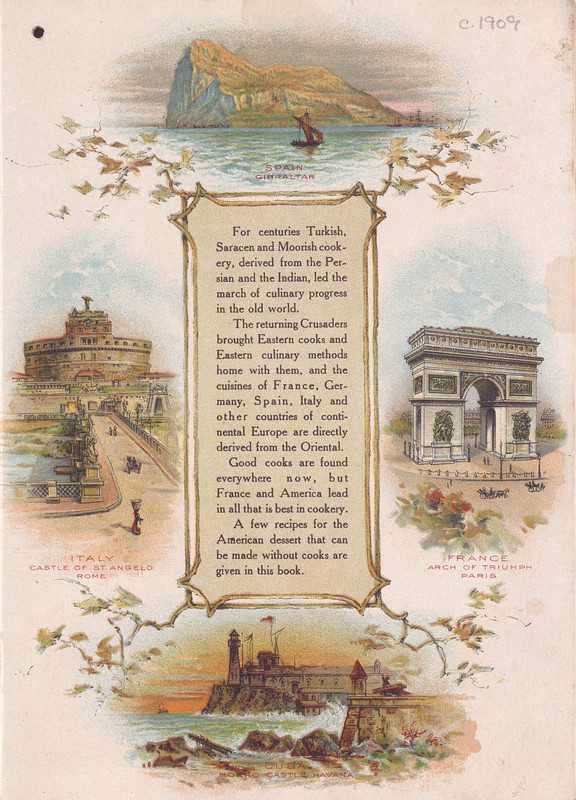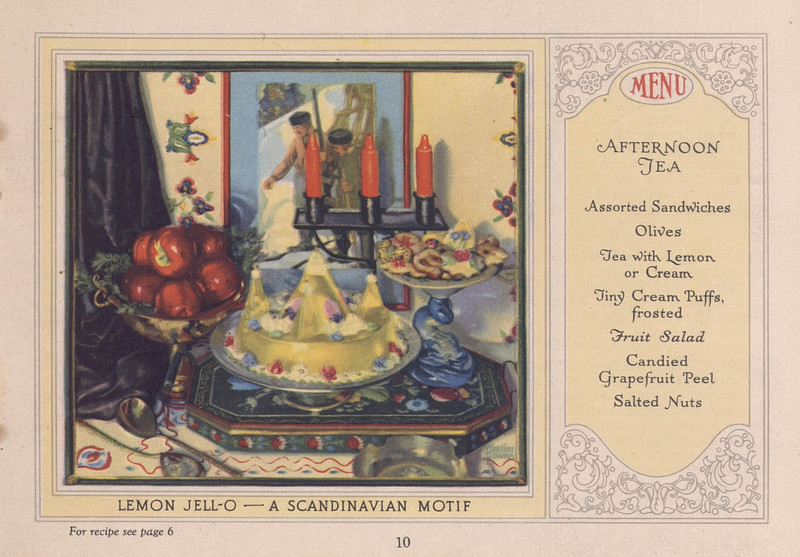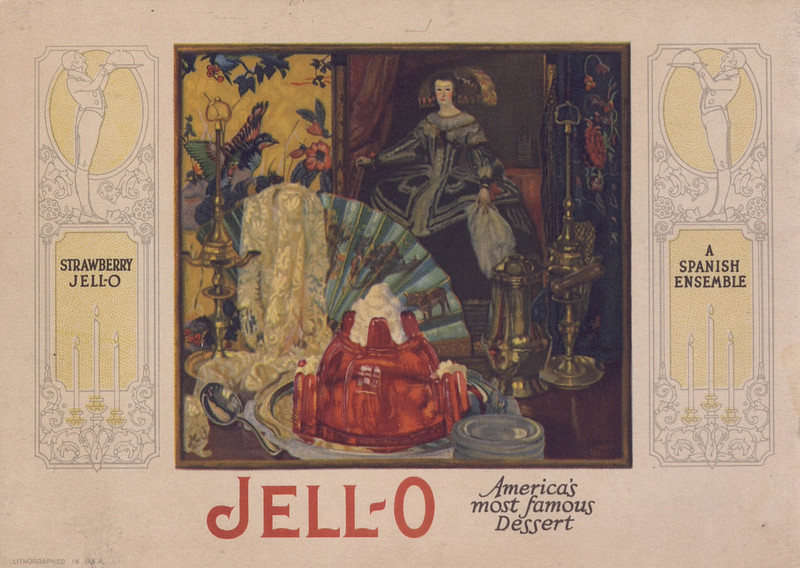Imagining the Other II
If Desserts of the World (1909) imagined what the world was eating (if it wasn’t eating Jell-O), and Jell-O America’s Most Famous Dessert: A Home Everywhere (1922) imagined Jell-O being consumed by all kinds of Americans, Jell-O America’s Most Famous Dessert (1926) imagined the rest of the world eating Jell-O. In An Oriental Group a Buddha figure presides over an elaborate Neapolitan Jell-O, accompanied by fruits, cakes, a silver spoon, and an empty vase, and framed by pink silk below and brocaded green silk above. This Orient is ornamental and constructed of fabric and objets d’art, not gustatory. The suggested ‘Company Luncheon’ menu ranges from Potatoes with Hollandaise to Bonbons, and includes no Asian ingredients or flavors.
In Jell-O Paradise Pudding - A La Francaise the menu for an “Inexpensive Club Luncheon,” includes meatloaf, succotash, and hot biscuits. Service à la Française refers to many dishes being served simultaneously on the dining table, in contrast to Service à la Russe, where multiple individual courses are plated for the diner in sequence. The Paradise Pudding anchors this image, framed by the commonplace objects typical of the still-life style: a coffee pot, a portrait, fabric and an empty vase. As with An Oriental Group (above), the still-life format surrounds Jell-O with a patina of age and of European status. Paradise Pudding is a mixture of creamed Lemon Jell-O thickened with marshmallows, almonds, maraschino cherries, and crushed macaroons.
In Lemon Jell-O - A Scandinavian Motif the menu for afternoon tea - cream puffs, candied peel, and assorted sandwiches - harmonizes with the illustration of ice cookies, fruit and a molded lemon Jell-O. Behind this scene is a portrait of two men participating in Military Patrol, a shooting and skiing antecedent of the Biathlon, which had just recently been showcased in the 1924 Winter Olympics. While held in France, the games were dominated by Norway and Finland, realistically connecting the Military Patrol to the titular Scandinavian Motif. Guns and Jell-O appear to be comfortable companions in this setting
For a Prohibition-Era advertising campaign, the most striking feature of Jell-O Plum Pudding - An English Service is the two decanters of liquid, presumably for drinking, as indicated by the two glasses adjacent. Traditional English plum pudding is set alight with brandy, which is probably a bad idea when your plum pudding is Lemon Jell-O enriched with spiced fruits and nuts. The Englishness of this setting is further emphasized by the food (walnuts, dried muscatels), the art (horses and carriages, more horses) and that quintessential English objet d’art: a Toby Jug. The dinner menu is a suitably English roast chicken and asparagus on toast, suggesting perhaps, that the producers of this advertising were much more familiar with English culture than with others.
While events in Spain edged slowly towards the Spanish Civil War, the symbolic elements of A Spanish Ensemble are royal, in both aesthetics and in the courtly figure in a large portrait. Recalling Diego Velazquez's 1656 Las Meninas (The Maids of Honor) it perhaps also references the contemporary royals, Victoria Eugenie of Battenberg, the wife of King Alfonso XIII. At the time of publication (1926), the King of Spain still supported dictator Miguel Primo de Rivera, and the royal family would not flee the country until the establishment of the doomed Second Spanish Republic in 1931. Ornate decorations, including a fan, frame the large Strawberry Jell-O capped with cream. As the back cover of America’s Most Famous Dessert, this image is edged by butlers in livery standing to attention, sentinels of large domed serving vessels, presumably with particularly elaborate unmolded Jell-O desserts hidden inside.

Imagining the Other I





